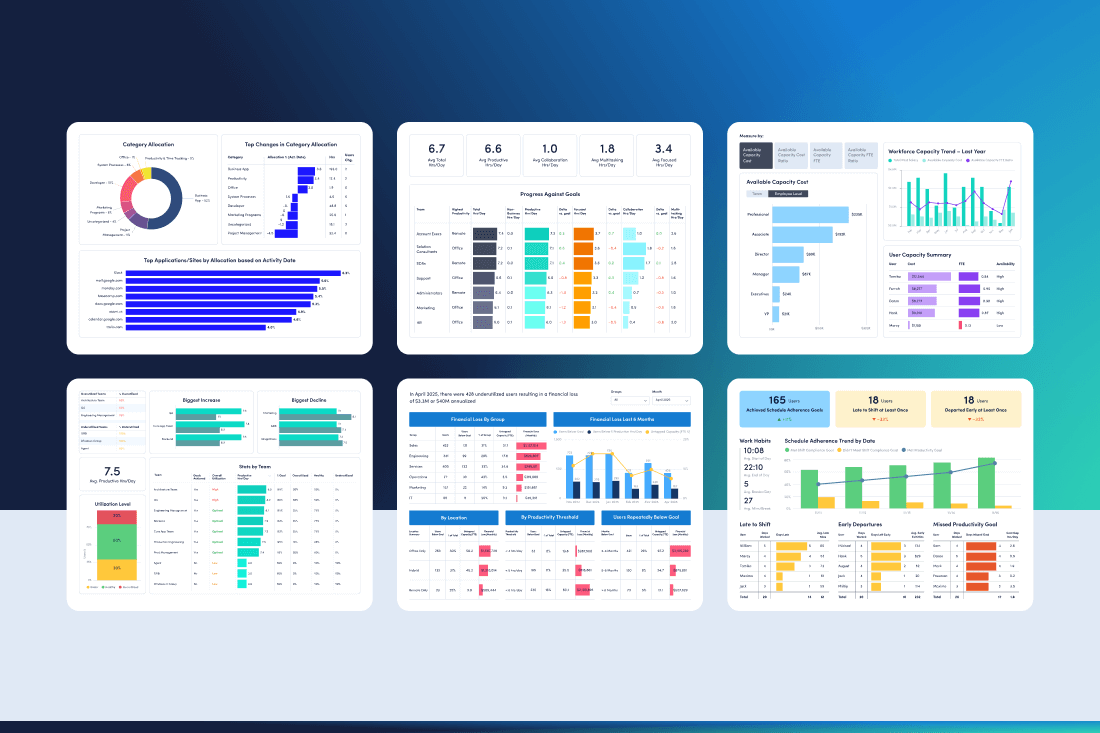Despite a recent wave of return-to-office mandates, remote work is here to stay — and it’s increasingly common across industries. According to the latest from Forbes, 16% of U.S. companies are already fully remote. And while 20% of employees currently work remotely,. 98% want to do so. In fact, by 2025, Upwork predicts more than 36 million workers will be remote.
To stay competitive in this shifting labor market, many companies are looking to offer remote opportunities to attract top talent.
However, remote work comes with many challenges. Managers face issues in supporting remote workers, especially when it comes to work-life balance, morale and company culture. A study from Pew Research found 53% of remote workers felt disconnected from their colleagues and 36% felt working from home reduces mentorship opportunities. According to Harvard Business Review, many leaders also have trouble trusting remote employees are working when they say they are.
Managers, HR leaders and executives alike have to strike a balance between the flexibility of remote work and the challenges it presents. The good news is research and years of practice have allowed experts to develop tips and tricks on how to support your remote workers.
In this post, we’ll share 11 best practices for supporting remote team members.
1. Use remote workforce management software
One of the hardest challenges in managing remote workers is visibility into productivity. Many managers feel if they can’t see workers at their desks, they can’t be sure employees are actually working. At the same time, workers may feel the time or effort they spend on work may go unnoticed when their boss can’t see how much they’re doing.
ActivTrak’s remote workforce management software gives team leaders, managers and employees visibility into productivity metrics to see when, how and where work is done. Get clear visibility into how workers spend their time to optimize remote schedules and see which apps and tools help or distract.
Intuitive dashboards show what impacts productivity, along with ideas on how to improve time management and efficiency. Managers easily see who may be overworked or underutilized, making it easy to devise strategies for balancing workloads, preventing burnout and providing development opportunities. HR leaders and managers also see where credit is due, while employees know their efforts aren’t going unnoticed because they see them on the dashboard.
2. Set clear remote work policies
Team members need to understand what “remote work” means to your organization. This means you have to set clear remote work policies and enforce them properly and consistently. Employees must have written guidelines to refer to when it comes to expected work locations, hours and availability, as well as how the company will track these items and what consequences they face if the policy is violated.
In addition, factor in any unique remote policies based on needs and compliance. Many companies need employees to work in states where the company is licensed to do business and to report from their home cities for a majority of the time for tax purposes. Some companies are held to compliance regulations that require employees to work from certain locations to ensure data privacy and security.
On the other hand, many remote-first workplaces allow employees to work from wherever they’d like. In these instances, the policy should cover how much information employees need to provide to managers when it comes to time zones, WiFi access or other concerns. Still other companies establish remote work as a reward for tenure or high performance. Employees need to know how and why they can work remotely or how they could lose those privileges.
Check out our remote work policy template to guide you through writing your own.
3. Establish regular syncs
Team meetings are important for any team to check in on progress, address bottlenecks and brainstorm ideas. Regular syncs are especially important for remote workers as they also add a rhythm to the workweek that keeps employees in touch with their colleagues.
Managers should schedule regular team meetings and 1:1s with individual workers so employees know they have time to ask questions and check in. At the same time, syncs reduce the urge for some managers to micromanage because they know they have a set time to discuss projects with each employee.
Keep in mind that overloading your employees with meetings can be just as detrimental as having too few. While any unnecessary meeting can be draining, video meetings take a special toll on employees (remember Zoom fatigue?).
4. Encourage communication and collaboration
Clear communication is the key to success in any business, but it’s especially important for supporting remote employees. Communication and collaboration tools are an excellent place to start. Employees need ways to get in touch with each other via phone, chat, direct message, email or video calls. They also need visibility into each other’s calendars as well as ways to indicate when they’re free or busy.
Online communication has also replaced the company water cooler as the place remote employees socialize. The company messaging platform should include work-related areas like team or project-focused rooms as well as social outlets like rooms to share photos of pets or kids.
Some common communication and collaboration tools include:
- Video conferencing tools like Zoom or GoToMeeting
- Collaboration tools like Slack or Microsoft Teams
- File sharing tools like Google Workspace or Microsoft Sharepoint
- Project management tools like Asana or Monday.com
- Calendars like Google Calendar or Microsoft Outlook to schedule meetings, track vacation and view availability
5. Provide the right tools and technology
According to research reported in the MIT Sloan Management Review just after the start of the COVID-19 pandemic, 44% of surveyed employees said providing technology for remote work is the best way to support remote workers. Remote workers need to be connected to the office through strong WiFi, updated laptops or desktop computers and the right communication and collaboration tools.
Employees should never have to find workarounds to company technology to get work done. Ensure new hires have the right equipment and technology to start work on day one. Work with your IT department to develop a robust inventory system to keep track of company property and ensure equipment is shipped or returned as needed. IT should also monitor updates and make it as easy as possible for employees to access the apps and tools they need without having to jump through too many hoops or wait too long for approval.
Providing workers with company-owned laptops, cell phones or other equipment is also a best practice for protecting company data and ensuring security compliance. When employees use personal laptops or cell phones for work, it’s harder to ensure they’re following company policies or staying compliant with privacy and data laws.
6. Ensure remote employees have a good work environment
Employees need a good work environment, and that doesn’t change just because they’re working remotely. While no organization can fully ensure an employee’s living space is clean and comfortable, you can help employees develop spaces that empower them to be productive.
If possible, include standard office equipment when an employee starts their role. Many companies give employees a one-time or recurring annual stipend to set up home offices as they see fit. Common equipment employees need includes:
- Office chair
- Desk/standing desk
- Mouse and keyboard
- Extra monitors
- Noise-canceling headphones or headsets for video calls
- Webcam
- Lighting tools
- Productivity tools like timers or day planners
Your organization should also provide ongoing training and tips for creating a productive work environment. Encourage employees to pool ideas on what works best for them so the company can adopt new tools as team members introduce them to the workplace. Each employee will have individual needs depending on location and work style, and managers must be ready to support them all.
7. Promote work-life balance
When they work from home, employees experience time differently than those who work in an office. There’s often no differentiation between “work time” and “home time,” as there’s no commute and constant access to work tools. For this reason, it’s important to establish policies that give employees time to unwind and leave work behind for personal time.
Managers should encourage frequent breaks throughout the day and urge employees to take allotted vacation days. Offer regular company holidays in addition to paid time off. Ensure employees feel safe delegating tasks while they’re away from their desks so they don’t feel compelled to work when they should be resting. And don’t contact employees during non-work hours unless it’s an emergency. Some employers have gone so far as to cut off access to email or company communications tools during certain hours.
It’s important for managers and executives to lead by example when it comes to work-life balance. If employees see their boss responding to emails on vacation, working long hours or fielding calls at all hours of the day, they will feel pressured to do the same.
Monitoring employee well-being is also important to provide the right support. Employees may not always report feeling overwhelmed or overworked, but workforce analytics metrics show managers when workers are heading toward burnout.
8. Recognize employee achievements and milestones
Employee recognition goes a long way in making employees feel important. But according to Quantum Workplace, less than 57% of workers feel their managers recognize them. It’s often harder for leaders to say “thank you” when they don’t work face to face. This is why it’s important to create a consistent employee recognition program that celebrates the work employees do as well as who they are as people.
Find ways to mark anniversaries and birthdays so employees feel seen. Develop ways for employees to call out other employees for positive experiences that may not be as easy to see as hitting deadlines or creating quality work. Track employee development and reward employees for improvements in time management or productivity as much as you reward them for quality work.
9. Create virtual team-bonding opportunities
Team building and bonding is a top priority for keeping employees engaged. Traditional happy hours, potlucks or other social events often aren’t possible when employees work from home. But there are other ways to build teams virtually.
Lunch-and-learns are a popular way for employees to showcase their skills or expertise while sharing time with colleagues and building relationships. Online exercise classes or meditation sessions are another way for employees to spend virtual time together. Virtual coffee breaks or happy hours provide employees a time to unwind and chat with each other even when they can’t meet in person.
Not every employee will want to socialize with their coworkers and some may find certain efforts corny or annoying. It’s important to let virtual teams decide for themselves what works best for building their relationships with each other to drive employee engagement and connectivity instead of adding another annoying item to their to-do list.
10. Offer resources to support physical and mental health
Employee health has come front and center since the COVID-19 pandemic, especially for remote workers. Burnout is ravaging American workers, with 65% saying they experienced it in 2023. And employees have recognized their employers’ role in addressing mental and physical health. According to the American Psychological Association’s 2023 Work in America Survey, 92% of workers say it’s important for employers to provide support for employee mental health.
Isolation is one of the main challenges to remote employees’ mental health, which is why regular check ins and communication tools are so important. Other important ways to support physical and mental health for employees include:
- Providing quality health benefits
- Giving employees access to mental health apps
- Creating well-being support groups
- Developing stress management programs
- Encouraging employees to be physically active through company-wide initiatives
Every organization will have its own approaches to mental and physical health, but it’s important to show employees they’re important to the organization.
11. Request feedback on areas to improve support
Remote workers often feel disconnected from their organization and may not know where to go to request more support. Companies should provide channels for employees to ask questions and make suggestions on how the organization can better support them. Managers should solicit this feedback regularly so employees feel safe offering it.
At the same time, the organization needs to make sure it implements the changes or provides reasons why the changes weren’t made. Employees who feel their feedback goes into a void are much less inclined to provide it in the future. And, in fact, they’re more likely to become actively disengaged employees, which is a bad development for your organization.
Support remote employees with ActivTrak
To support remote employees effectively, managers must prioritize clear communication and team cohesion, provide necessary tools and champion mental health. Following these best practices will ensure the success and well-being of your remote employees, leading to increased productivity and overall business success.
Leverage ActivTrak’s advanced workforce analytics software to gain actionable insights into remote and hybrid employees and foster a culture of productivity and well-being. Contact our sales team to learn more or to create your free account.





